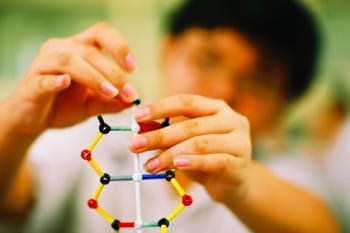
For many people, the first and last place they will ever study genetics is high school biology class. So it is crucial that these classes prepare people to deal with the barrage of genetic advancements that are increasingly impacting everyday life.
Unfortunately, many high school biology courses are not doing such a good job of communicating the fundamentals of genetics, according to an analysis by researchers from the American Society for Human Genetics (ASHG).
For three years now the ASHG, along with several partners, has sponsored the Annual National DNA Day Essay Contest. The contest challenges high school students to examine, question, and reflect on the important concepts of genetics. Shortly before DNA Day 2008, researchers used a selection of these essays from previous years to see where students might be going wrong. Their results were published in the journal Genetics.
Several themes emerged from the authors’ analysis. Most striking were the students’ lack of understanding of the limits to genetic engineering and their belief that single genes always determine traits and diseases.
The researchers attributed students’ misconceptions to “genohype” in media coverage of scientific discoveries, science curriculum standards that lack depth, and even the undergraduate biology education teachers receive.
Students often equated the identification of a disease-associated gene with “curing” a disease through gene replacement. A disturbing number of students thought genetic engineering could be used to “improve” and “design” their offspring, with the goal of having a “perfect” child.
Some students even suggested that genetic engineering would allow scientists to put a gene from one species into another in order to get a specific trait. For example:
“We could eliminate all the premature deaths of people dying around the world from thirst if we genetically modified people to inherit some of the characteristics of the camel, allowing them to go for months at a time without drinking water.”
The rules of the DNA Day Essay contest require teachers to submit the top three essays for each question from their students. The fact that so many essays were from students with serious misunderstandings suggested to the ASHG researchers that the teachers themselves may not be receiving very good undergraduate training in genetics, and that their unchallenged misconceptions are being passed on.
Like many before them, the authors of the ASHG study suggest that partnerships between scientists and educators will be valuable in improving genetics education. They propose shifting instruction from the simple Mendelian view of inheritance to a more nuanced perspective that takes into account multiple genetic and non-genetic contributions to traits and diseases, with a focus on concepts over content. But, they concede, this type of change is impeded by the need for districts and states to demonstrate content knowledge on standardized tests.
“Until significant research is performed by scientists and their educator colleagues that demonstrates which methods adequately teach both content and concepts, schools systems are unlikely to change their methods,” the authors write.
Some resources for genetics education: